Refer to the exhibits. The output of the trace route from R5 shows a loop in the network.
Which configuration prevents this loop?
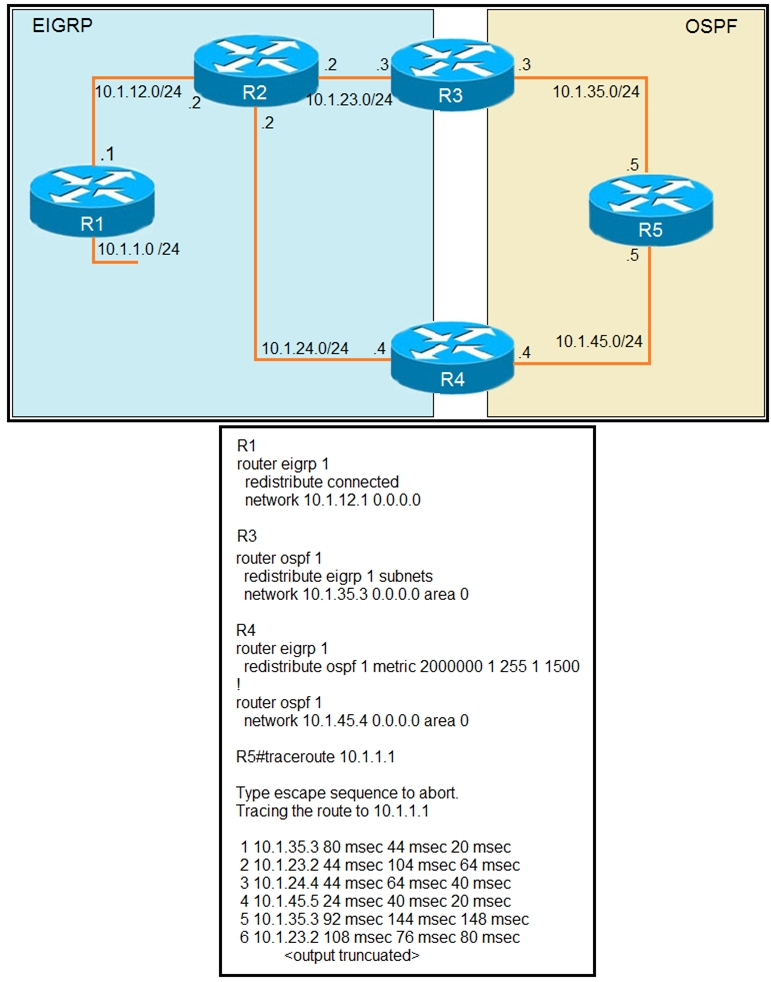
A.
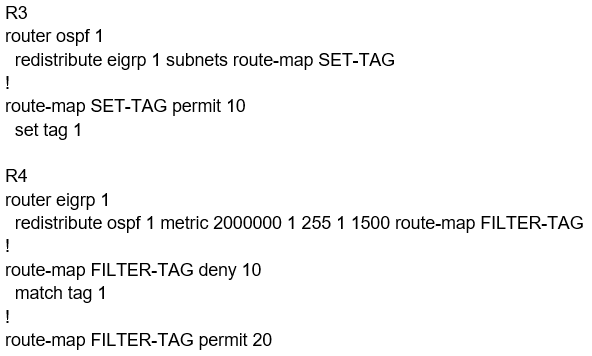
B.
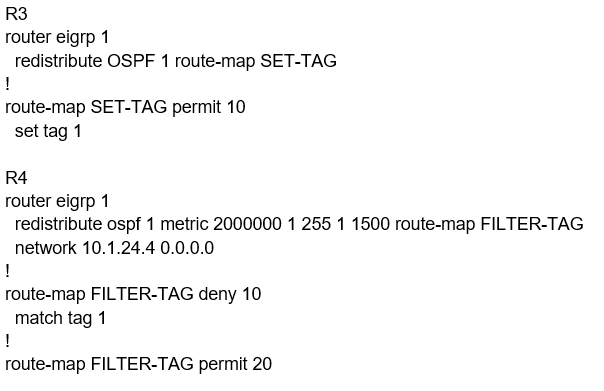
C.
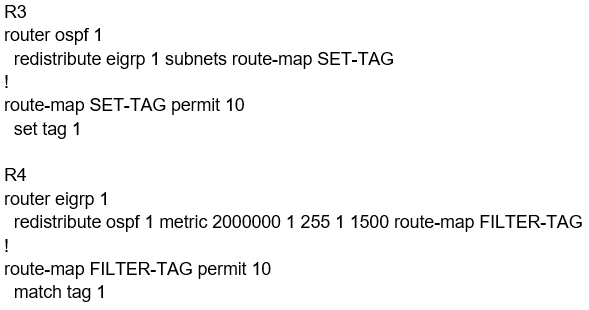
D.
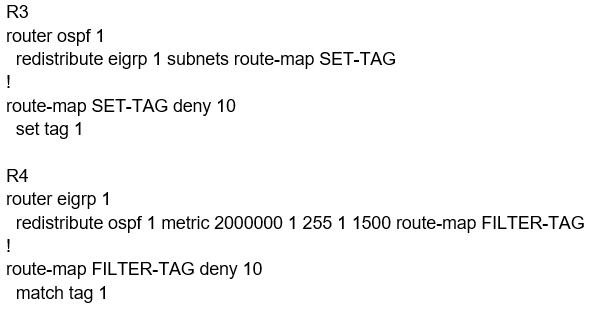
Refer to the exhibits. The output of the trace route from R5 shows a loop in the network.
Which configuration prevents this loop?

A.

B.

C.

D.

The configuration needed to prevent the routing loop involves the proper tagging and filtering of routes between the two different routing protocols, EIGRP and OSPF. This is essential to ensure routes are not constantly reintroduced into the other protocol, creating a loop. The configuration must include tagging the routes when they are redistributed from EIGRP to OSPF and then filtering them out when they are redistributed back from OSPF to EIGRP. The provided configuration in Option A follows these steps correctly: R3 redistributes EIGRP into OSPF with a tag using a route-map, and R4 redistributes from OSPF to EIGRP while filtering out these tagged routes, thus preventing the loop. Therefore, the correct configuration to prevent the loop is shown in Option A.
Answer is A but the available answers are all written wrong either way. Whoever wrote this is crazy. But, the CLOSEST possible answer would be A. Whoever writes questions for the Cisco exams are absolutely ignorant in how they write questions OR they are being deliberate in trying to fool the test takers, which is sad.
After a thoght analysis is not B, Il explain Why, R3 are redistributing OSPF into EIGRP and setting the tag 1, but notice that the tag 1 is being announced on EIGRP process, when R4 redistribute OSPF into EIGRP with the route map it will not match anything because that tag is no been announce by ospf process. So on R4 the R1 network will be redistributed back and being announced to R2, as the reported distance reset by redistribution then when packet arrives to R2 the R4 router will be prefered. In conclusion B is not Correct, the most closest is A
I see the same thing as Koume has described above. The network is not tagged in the ospf domain.
I see the same thing as Koume has described above. The network is not tagged in the ospf domain.
"A" I have redone this lab. Introduced the loop, then applied solution "A". It did actually prevented the loop. Before applying "A": R5#trac 10.1.1.1 Type escape sequence to abort. Tracing the route to 10.1.1.1 VRF info: (vrf in name/id, vrf out name/id) 1 10.1.35.3 2 msec 1 msec 2 msec 2 10.1.23.2 2 msec 2 msec 2 msec 3 10.1.24.4 2 msec 2 msec 2 msec 4 10.1.45.5 1 msec 2 msec 2 msec 5 10.1.35.3 3 msec 2 msec 2 msec 6 10.1.23.2 3 msec 2 msec 3 msec 7 10.1.24.4 3 msec 3 msec 3 msec 8 10.1.45.5 2 msec 2 msec 2 msec 9 10.1.35.3 4 msec 3 msec 3 msec 10 10.1.23.2 3 msec 4 msec 4 msec <output ommited> After applying "A": R5#trac 10.1.1.1 Type escape sequence to abort. Tracing the route to 10.1.1.1 VRF info: (vrf in name/id, vrf out name/id) 1 10.1.35.3 2 msec 2 msec 1 msec 2 10.1.23.2 2 msec 2 msec 2 msec 3 10.1.12.1 2 msec * 2 msec R5#
Prefix is tagged: R4#sh ip route 10.1.1.1 Routing entry for 10.1.1.0/24 Known via "ospf 1", distance 110, metric 20 Tag 1, type extern 2, forward metric 2 Redistributing via eigrp 1 R4#sh run | sec router eigrp router eigrp 1 network 10.1.24.0 0.0.0.255 redistribute ospf 1 metric 1000000 1 255 1 1500 route-map FILTER-TAG R4# R4#sh run | sec route-map redistribute ospf 1 metric 1000000 1 255 1 1500 route-map FILTER-TAG route-map FILTER-TAG deny 10 match tag 1 route-map FILTER-TAG permit 20
Before applying "A" - 10.1.1.0/24 is learned from OSPF: R4#sh ip eigrp 1 top 10.1.1.0/24 | sec External Composite metric is (2816/0), route is External External data: AS number of route is 1 External protocol is OSPF, external metric is 20 Administrator tag is 1 (0x00000001) After applying "A" - tagged ospf routes are filtered, 10.1.1.0/24 is learned from redistribute connected via eigrp: R4#sh ip eigrp 1 top 10.1.1.0/24 | sec External Composite metric is (131072/130816), route is External External data: AS number of route is 0 External protocol is Connected, external metric is 0 Administrator tag is 0 (0x00000000)
Before applying solution A, R2 sees two redistributed routes in eigrp, one from redistribute connected, and another from redistribute ospf. R2 trusts ospf more, and sends traffic to R4. Loop is created.
Before applying solution A, R2 sees two redistributed routes in eigrp, one from redistribute connected, and another from redistribute ospf. R2 trusts ospf more, and sends traffic to R4. Loop is created.
A is the correct answer. The reason for the loop is that R2 is forwarding the packets destined to 10.1.1.1 to R4, instead of R1. This is because in the redistribute OSPF statement, BW metric has a higher value and delay has a value of 1. So, R2 chooses R4 over R1 for 10.1.1.0/24 subnet causing a loop. Now, R5 learns 10.1.1.0/24 from R3 and advertises the same route to R4, that R4 redistributes back in EIGRP. If R3 sets a tag of 1 while redistributing EIGRP in OSPF, and R4 denies all the OSPF routes with tag 1 while redistributing, it will not advertise 10.1.1.0/24 back into EIGRP. Hence, the loop will be broken.
***(A) is correct Blue ---> Yelow (SET a tag) Blue <--- Yelow (BLOCK tagged updates back and permit not tagged) (B) wrong direction back Yelow --> Blue (SET a tag) Yelow --> Blue (BLOCK tagged updates and permit not tagged) (C) a permit statement is missing Blue ---> Yelow (SET a tag) Blue <--- Yelow (BLOCK tagged updates back and DO NOT permit not tagged) (D) a deny statement is used wrongly Blue ---> Yelow (DO NOT SET a tag) Blue <--- Yelow (BLOCK tagged updates back and DO NOT permit not tagged)
It is indeed A, the tag and filter should be in different protocols
A is the correct answer, the trick is that there is no mutual redistribution on R4 between OSPF and EIGRP. If you were to use mutual redistribution on R3 and R4 you would have to set different tags on both routers for redistribution from EIGRP to OSPF and then filter these tags when redistributing back.
The answer is A. I made a lab simulating the topology and configs. With the original config the loop was present. Answer A completed a trace and ping to 10.1.1.1. Answer B did not prevent the loop.
A is the answer. The C and D are wrong because it don't have permit all at the end of FILTER-TAG route map. B is not correct because the flow of redistribution is clockwise.
I'll go with A, 100% .
I would have said A
A is correct. In B the tag and filter are both in eigrp process.
A is wrong. B is correct. A is wrong because the R4 doesn't have any interface under EIGRP. no network statement in the given config. without the network 10.1.24.4 there will be no neighbor relation with R2.
For anyone that just started checking comments: DON'T LOOK ON COMMENTS OF THIS GUY. HE PURPOSELY POSTED WRONG ANSWERS TO EVERY QUESTION WHERE HE COMMENTED.
A and it's not that difficult, pay attention to each option: a) What protocols are redistributed (we are keeping the SAME protocols as in the exhibit). b) One router gets a route-map to "permit/set", the other gets a route-map to "deny" first router's tagged routes and "permit" if not tagged (that's why A is correct and C wrong).
Redistribution is "clockwise" so same config must be kept with some addition It's A
correct answer is A.
A is de correct answer. In B there is no redist into OSPF.
Correct Answer is A
I like A here. The problem with B is that the 10.1.1.0/24 subnet is not getting tagged on the eigrp to ospf redistribution at R3. Hence, R4, can't block it from on the ospf to eigrp redistribution at R4.
A is correct
Is this question malformed? I see no possibility for route looping based on the displayed configuration
A is definitely correct ...
A is correct according to me
A is the correct answer
A is the correct answer !!
Lab it and it's A
So EIGRP works on R4 without a network statement? How does the router know which interfaces are included in EIGRP if there is no network statement? The diagram shows EIGRP only on the left side, and not the right. How is this accomplished if not by the network statement?
Ans is A. On R4 without 'route-map FILTER-TAG permit 20', traceroute from R5 to 10.1.1.1 will stop at 10.1.35.3. Please help explain why is 'route-map FILTER-TAG permit 20' needed?
A is the correct answer, I tested it in a lab environment
The correct answer is: A
How can A be correct if EIGRP doesn't have a network command on R4?
It has, but it is omitted from the picture. Cisco exams questions are unfortunately sometimes written in a way, that you need to complete the missing parts of the question too, by looking at details. In this case it doesn't show the network command, but it shows, that it is in fact there by using the traceroute. If it wouldn't be there, than the network on the exhibit wouldn't have a loop, but it would be a one way only communication between the OSPF and EIGRP. I hope this isn't too confusing, but my conclusion is, that the command is there, just not shown on the picture, just to confuse the test taker
A is de correct answer. In B there is no redist into OSPF
I tested the options in GNS3 and the only one that works was option B. Given answer is correct
I was wrong the correct answer is A the tag go in the ospf direction on R3 because R4 waits tagging 1 to prevent the loop
According the configuration in R3 you redistribute EIGRP into OSPF and answer B say other wise, so A is the correct one.
In answer C and D is missing the permit 20 on the route map mining that no other routes will be added to the routing table and one of them has a permit so it still has the loop.
100%% option "A"
The right answer is A.
Answer is A. To stop routing loops when mixing EIGRP and OSPF, we use route tagging and filtering. when a router sends routes from one type of routing (like EIGRP) into another (like OSPF), it adds a special tag to those routes. This tag is like a note that says, 'Hey, I came from EIGRP!' Then, when another router is moving routes back from OSPF into EIGRP, it looks for that tag. If it sees the tag, it knows not to send those routes back into EIGRP again. This way, we avoid having routes go in circles, causing loops. if router R3 is moving routes from EIGRP to OSPF, it tags them. Then, R4, which is moving routes the other way, blocks any routes with that tag from going back into EIGRP. So, R3 tags the EIGRP routes with a '1' when sending them to OSPF, and R4 makes sure not to let any routes with a '1' tag back into EIGRP.
We are redistributing an OSPF subnet to EIGRP, so you need to go to EIGRP and issue the OSPF redistribution inside EIGRP. Answer is A, no debate is needed. Just look how the configuration is being applied and save your time.
Option A is the solution.
A is correct we must permit tag 1 on R3 and dney it on R4
After careful examination of the contested answers. A is the appropiriate answer because one cannot redistribute into eigrp without specifying the metrics. So B cannot be the answr.
Answer is A ,just did the lab Tracing the route to 10.1.1.1 1 10.1.35.3 20 msec 32 msec 28 msec 2 10.1.23.2 56 msec 64 msec 60 msec 3 10.1.24.4 96 msec 100 msec 96 msec 4 10.1.45.5 56 msec 60 msec 68 msec 5 10.1.35.3 88 msec 96 msec 92 msec 6 10.1.23.2 124 msec 116 msec 128 msec 7 10.1.24.4 160 msec 152 msec 148 msec 8 10.1.45.5 128 msec 128 msec 128 msec 9 10.1.35.3 160 msec 156 msec 148 msec 10 10.1.23.2 184 msec 196 msec 180 msec 11 10.1.24.4 216 msec 220 msec 220 msec 12 10.1.45.5 184 msec 188 msec 188 msec 13 10.1.35.3 204 msec 236 msec 200 msec after applying A 1 10.1.35.3 16 msec 36 msec 32 msec 2 10.1.23.2 60 msec 64 msec 56 msec 3 10.1.12.1 104 msec 100 msec 92 msec
my instructor says that setting tag and filter can be in same and/or different ospf/eigrp =equal or cross-over, that doesnt matter. Looking at the configs C+D have permit/permit deny/deny that doesnt work, A+B have a permit/deny combination which works. B has a network statement that A doesnt have ..
and the network statement is not needed for redistribution, so should be A.
I've never heard that rule before. Without a network statement, how does EIGRP know which interfaces to advertise out?
I've never heard that rule before. Without a network statement, how does EIGRP know which interfaces to advertise out?
In addition, answer B is missing the 'subnets' keyword in OSPF redistribution, A is correct
Ok, I am going back over these questions. Answer B does look correct. Look at the protocols that are being redistributed. Redistributing EIGRP from R3 wont make a difference to R4 that is already in the EIGRP area in that direction (R4>R5>R3>R2>R4). Redistributing OSPF to EIGRP tagging as 1, then dropping at R4 does make more sense.
The way redistribution is being done on R3 on option B does not work as we need to specify a metric. Option A is correct.
A is correct
A is correct
A is the correct answer and here is the result of the traceroute after implementing A R5#traceroute 10.1.1.1 Type escape sequence to abort. Tracing the route to 10.1.1.1 VRF info: (vrf in name/id, vrf out name/id) 1 10.1.45.1 52 msec 80 msec 40 msec 2 10.1.24.1 156 msec 148 msec 132 msec 3 10.1.12.1 204 msec 152 msec 156 msec
A is the correct since B is not redistributing EIGRP into OSPF area.
A is the correct answer here
Only A will work. But I'm not sure that there is needed to add permit in route-map at R4, because all not matched tag will be permitted.
I think its B If the R5 sends a ping to R1 the rote map only applies for Eigrp - ospf to set a tag of 1 so traffic originating from R5 will not have a tag of 1. When traffic is coming back from R1 the rote map on R4 is from OSPF-EIGRP deny tag however this will not work, answer B is correct because traffic from R5 will be staged with a Tag of 1 because its from OSPF-EIGRP and R4 is also OSPF-EIGRP deny tag 1 , so I stick to B
correct answer is A.
Answer is B. R1 is advertising the connected 10.1.1.0 as an external network AD 170. OSPF advertises it as 110 so by default R4 will take the path through R5->R3 to get to 10.1.1.0. R2 IS advertising it at 170 to R4 even though it is a shorter path. If we block advertisement from R5 for this network then the better path of R4 -> R2 will be chosen.
For me also "A" seems to be the closest, because it is applying the tag on the correct combination of protocol & router. I labbed this scenario in CML, but I was unable to reproduce a loop with this configuration.
B is the correct answer from the fact that R4 advertised the important route of 10.1.24.4, which other options did not. Also technically set tag1 in R3 and denied it in R4.
no is not, in eigrp you need to specify the K values for redistribution otherwise the routes will be redistributed with infinite metric which means they are not valuable routes. EIGRP needs the K values because it does not have an active algorithm like ospf but is just a formula using by default bandwith and delay.
ok I have read half of it please ignore my comment LanreDipeolu
ok I have read half of it please ignore my comment LanreDipeolu
The answe is A. I have my CCIE written certification. Please refer to Hungarian Dish Comment.
seriously ? redistribute ospf into eigrp on both router 3 and 4 ? Nahh Its A